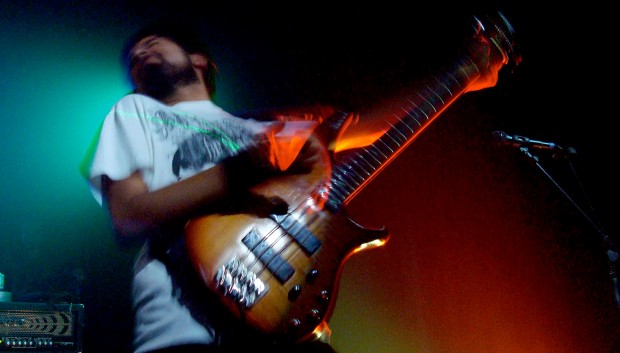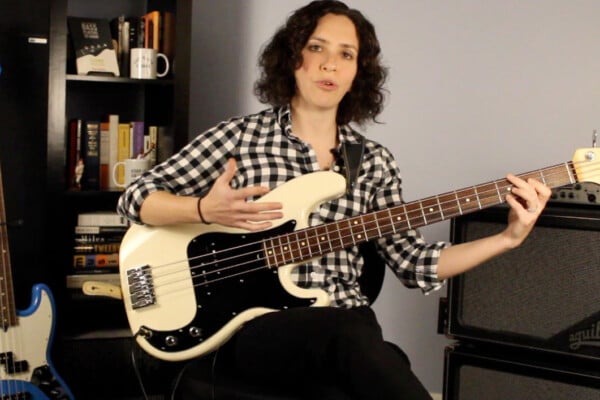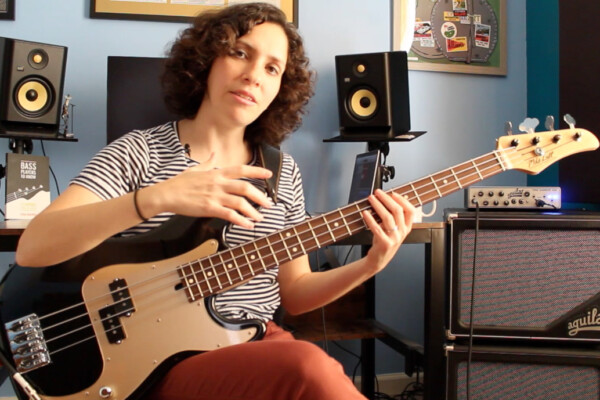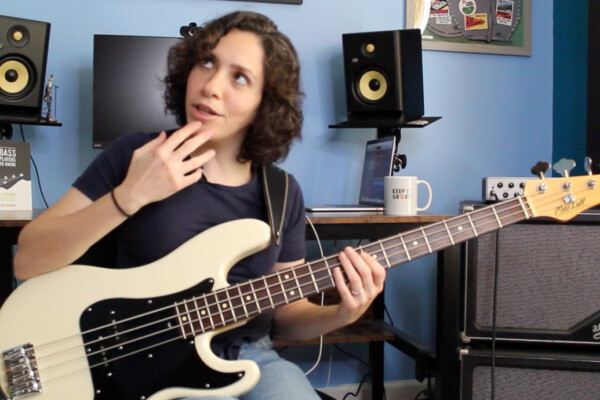A Discussion on Slap Bass Tone and Technique

I get a an insurmountable number of emailed questions asking about slap tone and technique.
While I have mentioned dozens of times in various columns that I never really explored the slap side of bass, I have fiddled with it enough, in addition to knowing quite a few fantastic slappers. I know how to get the tone, I just never got comfortable with the technique, therefore I never pursued it. I’ve opted to instead take the rhythmic approach and combine it with the use of the thumb to develop my own little style of finger style playing that suits my approach to playing the instrument.
So, I thought that I might as well let you guys know everything that I know.
EQ:
Almost in direct opposition to what I say with regard to fingerstyle playing (all the tonal magic happens in the lower and upper mids), slap tone is all about the mid-scoop. On a graphic EQ, this looks like a smiley face. Really, you are enhancing the lows (for the thumb ‘slaps’) and the highs (for the ‘pops’).
This can be achieved by dropping your mids (if you have a 3-band eq), boosting the bass and treble, or a little bit of both.
Technique:
There is no one way to slap (or to do anything, really) but there are two prominent techniques that I’ve seen with regard to what your thumb is doing. Let’s go there first and then talk about the pluck.
The Bouncing Thumb
I just made that name up – and it’s not a very good one – but it accurately describes what many pre-Victor Wooten bassists showed me back in the day. The thumb acts like a hammer but recoils quickly from the string, allowing it to ring. I was taught to attack the string with my hand in a bit of a hitch-hikers pose and use my wrist (not your arm – don’t waste energy) to pivot my thumb to and away from the string. I hit the string pretty much right on the side of my knuckle.
I was always most comfortable when I kept my forearm pretty parallel with the neck and simply rotated my thumb to the string and back via a simple wrist flick.
Thumb-thru
While I don’t know if Victor Wooten was the first (I suspect that Larry Graham did this a bit as well), he certainly popularized the technique and took it to new levels. The difference here is that, instead of hitting the string dead on and bouncing away, you strike through the string. This allows you to strike the string again on your way back up with your thumb.
Instead of hitting the string with the side of your knuckle, you will now be using the left-most quarter of your finger pad for the down-stroke and your finger-nail for the up-stroke (for right handed players, anyway. Reverse this if you’re a lefty).
You are basically using your thumb as a pick and can effectively double the speed of your thumb ‘slaps’ using this technique. Very helpful for fast lines or even those super-funky sounding 16th-note, one or two-string grooves you hear so much of these days.
The Other Fingers
Traditionally, players ‘popped’ with the index finger. The main thing to explore is how much “purchase” you want your finger to have. Too little and you may not get the attack that you want, too much and you may wind up breaking strings like crazy (at least I did as a kid). You only really need about 1/8th to 1/4th of an inch of your finger (the inside or right side of the finger for right-handed players) to get a good hold and snap it up up.
These days, bassists are learning to pop with two or even three fingers (index, middle, ring) to – again – increase the speed available to their lines.
The main thing to keep in mind here is economy of motion. You don’t need a ton of arm motion at all to achieve a good sound. The more efficient you are, the faster you will be able to play (and with more accuracy).
Your Bass:
Not all basses are created equal for slapping. Beyond what I’ll mention in a bit with regard to any on-board pre-amps you may have, the crucial thing here is the wood used in the instrument. I don’t know how much body wood plays a role, but I do know that most players tend to favor maple necks when slapping. It has a nice rich sounding attack that isn’t too dark or woof-y.
I have noticed that a popular combination is an ash body with a maple neck. That seems to be the go-to for many popular slap bassists. That’s about as much as I can speak on in that regard.
Pickups and Onboard Preamps:
The thing here is that you want fairly bright sounding electronics. Dark and growly is great for fingerstyle, but you need a lot of attack to your tone to get a great slap sound. I don’t know which combination will sound best to you so I urge you to explore what your slap heroes are using.
Strings:
This is a biggie. Round wound steel strings are usually the way to go. Some do use flats, nickels, half-rounds, etc., but when going for a bright sound with rich overtones, round wound steels are pretty much the ticket. You should also experiment with string tension. Lower tension strings will give you more give in the strings. This will help you to a) not break them constantly b) achieve a slightly greasier, bend-y type right hand expression. Many companies are putting out low tension strings these days. D’Addario has “Flexsteels” which I love, even though I don’t really slap and usually prefer nickels. They feel pretty amazing. Check out this video that I took part.
Dunlop also has the “Super Brights” which are fantastic as well.
Effects:
This is definitely uncharted territory for me as I don’t really explore effects and how they operate in a slap setting. That said, I do know that a touch of compression can go a long way to making a line pop out in the mix. I have really fallen in love with the MXR Bass Compressor. It’s very user friendly and really enhances your tone without changing it too much.
I hope that gets you going on your tonal journey!
Chances are that some of you know more than I about this, and I very much encourage you to lend us your thoughts in the comment section.
Have a question for Damian Erskine? Send it to [email protected]. Check out Damian’s instructional books, Right Hand Drive and The Improviser’s Path.




Nice article. I believe Stanley Clarke gets the credit for the first double thumbing, although I don’t recall the track in question. Some great FX to try on slap are envelope filter, chorus/flange/phaser and/or a tiny amount of octave below (a la Marcus Miller). Cheers.
Bouncing thumb, or when your guitar player buddy grabbes your bass to show you his “awesome bass chops” lol.
Hi, my index finger gets stuck when popping..should I use a slap ramp or work on my technique?
Your technique! If you learn popping you’ll always be able to play properly slapping. Material is not forever, but knowledge is!
Is slap bass still alive? Of course you will always have slap virtuosos, as you’ll always have guitar shredders, but is it me or the latest tendency on most music genres is a return to traditional finger picking?
Check out Larry Graham going to town with the double thumbing on the track ‘Release Yourself’, from 1974! Also, Doug Rauch did it even earlier on ‘Giants – Attitude’, recorded in 1971. For those old school slap tones, you really want to be leaving the mids in, or even boosting the low-mids slightly.
I think the smiley face slap tone works well in your room when practicing, but when playing live, I think the mids should be at least flat. In genres where there is still a fair amount of slap like Urban Gospel, tends to favor mid heavy basses because they do cut through the mix live and recorded.